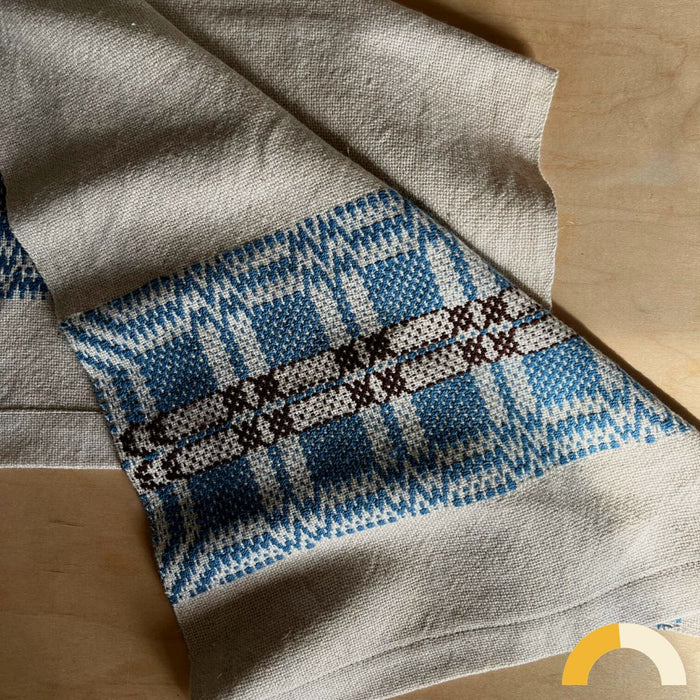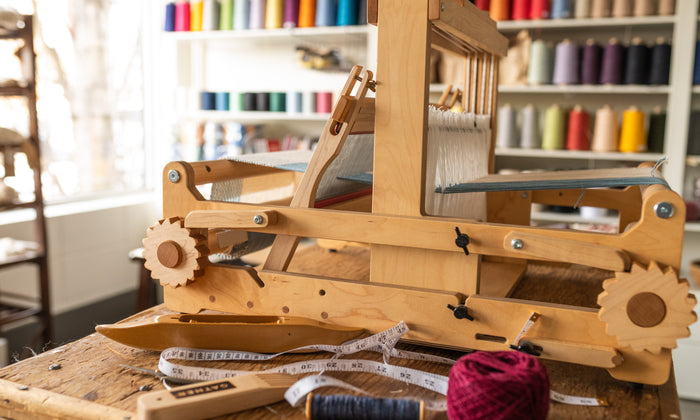Cotton is a fabulous fibre that is extremely popular with weavers.
At Gather, we stock more cotton yarn than any other kind and we constantly have cotton projects on our looms. If you’re planning a project using cotton, here’s what you need to know!

Cotton is Versatile
Cotton is an incredibly versatile weaving fibre that can be made into a wide range of practical textiles. Like wool, cotton makes soft and comfortable wearables, like scarves, shawls, and yardage for sewing garments. But unlike wool, cotton is also absorbent and machine-washable. This means it can be used for kitchen and bathroom textiles as well, like towels and washcloths, as well as items that need frequent laundering, like baby blankets.
Cotton is readily available in many different colours which is invaluable when you are planning projects. Gather carries over 80 different colours of cotton weaving yarn! That lets you get your best friend’s exact favourite blue for a scarf, or build your own rainbow for a baby blanket. Instead of picking one skein for warp and one for weft, you can use cotton yarn like a palette of paint colours, adding a little bit of this and a little bit of that until you get the effect you want.
There are also a variety of different textures of cotton yarn available. Cotton slub is a thick-and-thin yarn that adds gentle waves of rustic texture to a woven piece. Our Checked Scarf pattern uses slub yarns in both warp and weft to make subtle cris-crossed fields of texture. If you’re looking for all-over texture and body, boucle cotton is a great option. It’s nubbly and bumpy, perfect for kitchen towels and scrub cloths.
Cotton is Easy to Use and Care For
Cotton also plays well with other fibres. You’ll find many different cotton blends out there, combining the benefits of cotton with the characteristics of other fibres. Cotton and linen are frequently blended to make yarn with cotton’s softness but linen’s strength and sheen. Cotton/bamboo is another popular blend. Some of cotton’s absorbency is lost in this blend, but its fluffy body pairs beautifully with the slinky softness of bamboo.
And blending doesn’t have to happen at the level of yarn! You can also pair 100% cotton with other fibres in the same project. nWe often weave cotton warps with cottolin, linen, silkpaca, bamboo, or wool wefts. Since cotton is usually cheaper than the other fibres, using it for warp reduces overall project cost. And it’s much easier to stomach cutting off a couple feet of loom waste if it’s made up of cotton rather than a hard-to-find luxury blend!
Because cotton is an easy-care fibre, you can throw pieces made of cotton straight through the wash. I even use the washing machine to wet-finish my cotton pieces. To do this, zig-zag stitch or serge any raw edges. Wash on regular intensity with warm or hot water, then dry on medium heat. Give your weaving a firm press with a hot steam iron after washing. Cotton gets so much softer once it has been broken in a little bit. You’ll be amazed how much your weaving transforms with a thorough, vigorous wash and iron.
The Key to Loving Cotton: Good Tension
With all these benefits, it’s hard to believe that cotton has a reputation among beginners for being a bit intimidating. The reason for this is that cotton is relatively inelastic compared to some common yarns. When you put different yarns under tension, some will stretch and others will not. Wool is fairly stretchy, and acrylic yarn is extremely stretchy. Cotton is much less stretchy (although it still has more stretch than linen and silk!). If you nail your warping and tension with cotton yarn, it is an absolute dream to weave with. The weft beats in evenly and cleanly.
If you don’t nail your tension, though, weaving cotton can be a different story. Many weavers are surprised that even though they can warp reasonably well with wool or acrylic, they don’t get as nice a result with cotton or linen. This is because stretch in yarn will cover up any bad habits you might have; less-stretchy yarn will make them more obvious. If you warp with uneven tension using a stretchy yarn, some ends will stretch a bit more than others to even that tension out for you without you even noticing. Try the same thing with less elastic yarn, and there’s no get-out-of-jail-free card. You will be able to clearly see which threads are tighter and which ones are a bit droopy.
This isn’t a bad thing! In fact, it’s very helpful. If you aren’t aware of tension issues, you won’t have an opportunity to improve your warping skills. And once you have a chance to learn how to wind on with accurate, consistent tension, you can take those skills back to your stretchy yarns and create even cleaner and better pieces with them. It’s like learning to drive in the winter--once you master the more difficult version of a task, the easier ones seem like a piece of cake.
Understanding Cotton Sizing
The names for different sizes of cotton yarn are often confusing to new weavers. Knitting yarn is often labelled with a named size (fingering, worsted, etc.) or a single number (size 0 for lace through size 6 for bulky). Weaving yarns are more commonly labelled with two numbers; for example, 8/4 cotton or 18/2 merino. The first number refers to the size of each individual thread that has been plied together to make the yarn. The bigger the number, the skinnier the thread. The second number refers to the number of plies. So 8/4 is twice as thick as 8/2, since it has 4 plies of size 8 thread instead of just 2. And 16/2 is thinner than 8/2, since it has the same number of plies, but each ply is a smaller size. To make things even more confusing, some people (mostly Canadians like us) put the number of plies first and the size second. If you see 4/8, don’t worry. It’s the same thing as 8/4. Whichever way around it’s written, the larger number is almost always the size of thread, and the smaller number is the number of plies.
Our Sett Chart has guidance for how many ends per inch work best with each size of cotton as well as other yarns we stock. Here’s a cheat sheet just for common cotton sizes, organized from skinniest to thickest:
16/2 Cotton: (Sett 20-30 epi) Delicate and super-fine, but still strong enough for warp if handled with care! Used for drapey shawls, fine table linens, and ground warp/weft for complex patterns. Practice with some heavier cotton before trying! Can be used as weft on an 8/2 cotton warp for great drape and sharp pattern shapes.
8/2 Cotton: (Sett 16-20) This is the bread-and-butter size of cotton for four-shaft weaving. Easily strong enough for warp. If you’re not sure where to start, start here! Used for scarves, tea towels, cowls, and more.
8/4 Cotton: (Sett 10-16) A heavier cotton used for warmer scarves, table runners and heavy-duty tea towels. Great for rigid heddle weavers as it weaves up well in a 10-dent or 12-dent reed. Super strong.
8/8 Cotton: (Weft only) A very thick “mop cotton” that is generally not used for warp due to its size. Useful for heavy weft on placemats, blankets, and rugs.
It’s hard to fit everything there is to know about cotton into one short resource, but hopefully this gets you going! As you keep weaving with cotton, you’ll learn more and more about this staple fibre.








